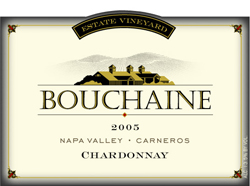

Bouchaine Vineyards
2005 Chardonnay, Estate Vineyards(Carneros ~ Los Carneros)
As a journalist, first as a sportswriter, then as a wine writer, I’m always being asked, “What is your favorite team?” and now “What is your favorite wine?” I don’t have a “favorite,” because I’m always rooting for the story, not the team or the wine. But I have to tell you, I root for the Carneros. Because Los Carneros – once the original frontrunner with Chardonnay and Pinot Noir – is now the decided underdog. The Russian River and the Anderson Valley and upstarts such as the Santas (Barbara, Rita and Lucia) have come out of nowhere to forge ahead.
But I’m telling you, don’t give up on Carneros. The folks down there in southern Napa Valley are again making some fine Pinots and Chardonnays. There are many reasons: New blood, new plantings and new clonal selections. Mike Richmond, for one, planted new clones in Bouchaine’s Chardonnay vineyard – much of which was planted in 1981 – and he’s produced a wine such as the 2005 Estate Chardonnay. The wine shows lots of minerality and Crenshaw melon in the nose, while on the palate the wine is lush and elegant with, a bit too much oak. But the acidity (3.31 pH) in the back-palate mitigates any sweetness from the wood. And with time the oak will integrate and over the following half-dozen years, you’ll see what Carneros can do.
Eighty-five percent of the juice was barrel fermented for nine months in 20 percent new barrels and 20 percent each of varying barrel ages, from one to four years.
Reviewed July 10, 2007 by Alan Goldfarb.
Other reviewed wines from Bouchaine Vineyards
The Wine
Winery: Bouchaine Vineyards |
The Reviewer Alan Goldfarb
Alan Goldfarb
Alan Goldfarb has been writing about and reviewing wine for 17 years. His reviews have been published in the St. Helena Star, San Jose Mercury, San Francisco Examiner, Decanter, and Wine Enthusiast, among others. Not once has he used a point system, star system, or an iconic symbol to quantify a wine. What counts in Mr. Goldfarb’s criteria when judging a wine is: how it tastes in the glass; is it well-constructed; its food compatibility; and presence of redeeming regional attributes. |













